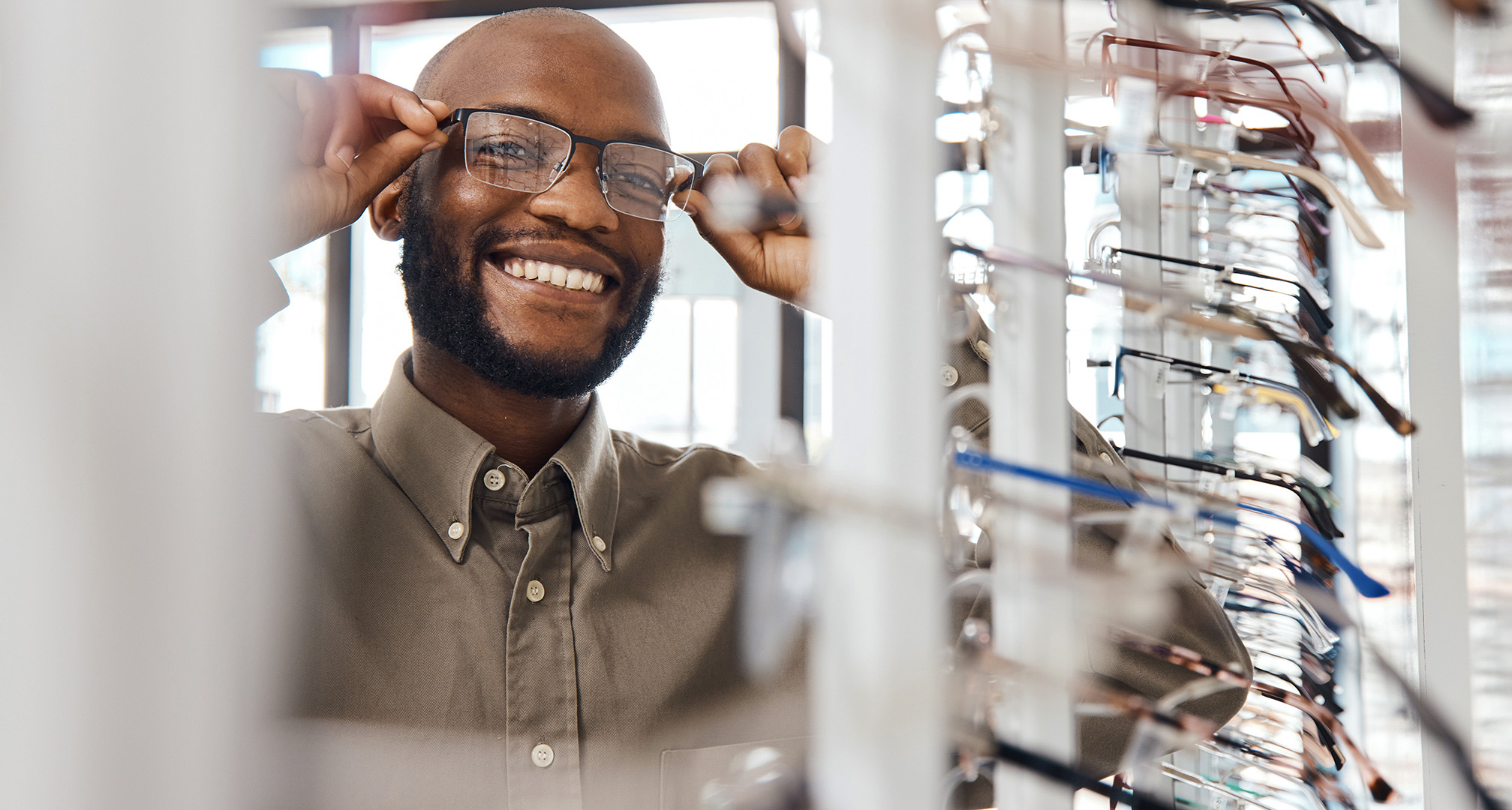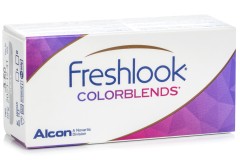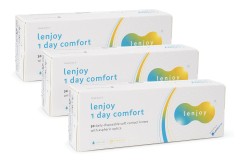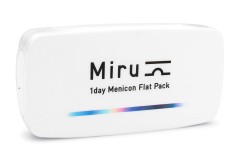How should your glasses fit?

Table of contents
Do you constantly have to push your glasses into place after they slide down your nose? Perhaps you've developed a habit of removing them to relieve discomfort throughout the day, only to uncover unsightly red marks.
For the best vision correction and wearing satisfaction, glasses should fit securely yet comfortably. The goal is to almost forget you're wearing them!
From the bridge of your nose to behind your ears, the Lentiamo opticians explain how glasses should fit each part of your face for optimal comfort. Follow along to see if your specs fit right.
Where should glasses sit on your face?

Glasses should always fit comfortably on the bridge of your nose. They shouldn't rub against your cheeks, eyebrows, or forehead. When you shake your head, wrinkle your nose, or squint, the frames should stay put.
Here's how they should fit each part of your face:
How should glasses fit your eyes?
Your glasses should fit so that your pupils sit almost in the centre of the lenses. This ensures you can see clearly without unnecessary obstructions in your vision.
How should glasses fit your eyebrows?
Your glasses frames should sit just below the browline. Ideally, your eyebrows will be visible above the top of the frames. You'll find that if your brows are obscured altogether or the lenses extend above them, it will look a bit unnatural.
Where should glasses sit on your nose?
Properly fitting glasses should sit on the bridge (top) of your nose. They won't pinch, wobble around, or slide down when you raise your eyebrows, squint, or wiggle your nose.
They shouldn't sit on the tip of your nose either. This makes it hard to see clearly when looking straight ahead.
How should glasses fit behind ears?
The ends of the temples should bend down gently at a 45-degree angle, just past the top of your ears. About 30 to 45 mm of the arm should extend beyond this bend, conforming gently to your head's contours.
The temples shouldn't begin to curve before they meet the ear. This will cause rubbing and discomfort.
How should glasses fit your cheeks?
Your glasses shouldn't rest on your cheeks but sit comfortably above or in front of them. If your frames lift up when you talk, smile, or chew, it might be because they're resting on your cheeks.
How should glasses fit your head?
Glasses should fit securely yet comfortably. Rubbing behind the ears, tightness or pressure points, or slipping of any kind means you should adjust your glasses frames.
Frames that are too tight will be uncomfortable, and frames that are too loose can be downright annoying.
What affects the fit of glasses?

Frame size and weight
The size and weight of your frames can impact how well they stay in place and feel on your face. Frames that are too small may pinch or cause discomfort. Frames that are too big or made from heavier materials will constantly slip down.
Additionally, heavier glasses can place unnecessary pressure on your nose and ears, leading to discomfort during extended wear. Finding the right size glasses and weight is essential for a snug and comfortable fit.
Pro tip: Frame materials like titanium or aluminium are lightweight and durable. High index lenses (thin lenses) and modern lens materials like polycarbonate are great for achieving an overall lightweight and comfortable fit.
Nose bridge
The upper part of your nose and the middle part of your glasses is referred to as a nose bridge. A glasses nose bridge is the primary point of contact between your frames and face. A well-designed glasses nose bridge will fit the contours of your nose and distribute the weight of your glasses evenly. This prevents them from slipping down or causing discomfort.
An ill-fitting or poorly adjusted nose bridge can lead to pressure points, red marks, and constant adjustments throughout the day.
Did you know? Nose bridge width varies between 14 and 24 millimetres. A lower number means your bridge is narrower. Some people might have higher or flatter nose bridges than others. Glasses with adjustable nose pads are a great option for a custom fit.
Temple arms
Temple arms determine how glasses sit on your ears. They also impact the overall balance of the frames. Too short and they'll pinch behind your ears. Too long and your glasses will slide down.
The right amount of curvature at the ends of the temple arms is important too. This is what determines a comfortable and stable fit.
Frame alignment and eye position
Proper frame alignment ensures lenses are correctly positioned in front of your eyes, optimising vision.
Additionally, frame alignment affects the aesthetics of your glasses, enhancing or detracting from your overall look.
Pro tip: When considering if your glasses are crooked or not, you can also pay attention to how they align with the bottom of your eyes. Eyebrows and ears are sometimes uneven, which can be misleading when trying to decide if your frames are sitting properly.
Pupillary distance (PD)
Your pupillary distance (PD) is the distance between your pupils. This measurement determines where the optical centre of your lenses should be. The right PD is an important part of the overall fit and feel of your glasses.
Face shape
Everyone's face shape is different, with the eyes, nose, and ears in different positions on each face. What works for one face might not work for another.
Using virtual try-on tools and finding your face shape can ensure the best look and feel.
Pro tip: Check out the best glasses for oval faces or the best glasses for round faces. This can give you an idea of how different styles work on distinct face shapes.
Other things to consider
Age
Glasses that rub, pinch, or just don't fit right can cause serious damage to the skin of older adults. As we age, we experience a loss of sensory receptors that enable the body to feel pressure, pain, and temperature, making older adults less able to detect changes in the environment and, therefore, more prone to injury.1
Lightweight, flexible materials like titanium or memory metals should be prioritised.
Materials
We know that heavier materials like metal and glass weigh more and can drag glasses down. Skin sensitivities or allergies to materials like nickel can also be irritating. Lightweight and hypoallergenic frames are important for both fit and comfort.
Diverse needs
For some, wearing glasses can be a sensory problem. Others may have different facial proportions that make wearing some traditional frames uncomfortable.
Lightweight materials, rimless styles, head straps or glasses chains, silicone nose pads, and more can make wearing glasses more comfortable. Additionally, adjustable nose pads can provide a customised fit that minimises pressure points. Your eye care specialist can even recommend other solutions specific to your vision needs, such as contact lenses.
Assistive devices
Compatibility with assistive devices such as behind-the-ear hearing aids can present challenges. To achieve a comfortable fit while ensuring both glasses and hearing aids work properly, consider flexible or thin metal temple arms. Lightweight materials can also alleviate discomfort and pressure while ensuring proper audio quality.
See what works best for you such as fitting your glasses before donning your hearing aids. Speak to your health care professional and they can help find solutions specific to your needs.
Looking for the right prescription glasses?
Check out a wide range of stylish options today.
What can improperly fitted glasses cause?
In addition to general discomfort, here's a quick summary of what can happen if your glasses don't fit right:
- Slipping due to loose frames or heavy materials
- Crooked frames from poorly adjusted frames
- Pinching behind ears or on nose that leads to discomfort
- Rash or redness from irritating materials or rubbing
- Nose marks from tightness and pinching
- Eye strain from incorrect prescription alignment
- Headaches from pinching on the nose bridge or temples
Frequently asked questions
Should glasses be tight or loose?
Glasses shouldn't be too tight or too loose. The ideal fit is snug but comfortable, ensuring your glasses stay in place without causing discomfort or pressure points. They shouldn't move around when you move your head or bend over.
Is it okay to wear oversized glasses?
It's okay to wear oversized glasses as long as your lenses align properly with your eyes, the frames don't slip or feel uncomfortable, and the frames can accommodate your prescription. Keep in mind that as frames get bigger, they can get heavier too.
How do I tell if my glasses are too small?
If your glasses are too small, you'll be able to feel they're tight or put pressure on your ears, temples, cheeks, or nose. You might notice that when you look in the mirror, your eyes aren't centred in your lenses but rather positioned closer to the sides of the frames.
How should sunglasses fit?
Sunglasses should fit comfortably with the nose bridge resting securely on your nose, providing a snug (but not tight) fit. The frames should sit evenly on your ears, preventing them from slipping down or feeling too loose. Ensure the lenses cover your eyes completely for effective sun protection.
Closing thoughts from Lentiamo
Poorly fitting glasses aren't just annoying, they can impact your vision and daily life. Ensuring your glasses fit properly helps you stay comfortable and keeps your vision clear.
We hope this article from the Lentiamo opticians helps you make the most of your frames!
Read more
Check out how to buy glasses online and get one step closer to finding your perfect fit.
Sources
1. Nursing Times, Anatomy and physiology of ageing 11: the skin








Comments